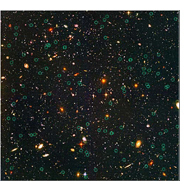Compared to ground-based telescopes, Hubble
is not particularly large. With a primary mirror diameter of 2.4 meters
(94.5 inches), Hubble would at most be considered a medium-size telescope
on the ground. However, the combination of its precision optics, location
above the atmosphere, state-of-the-art instrumentation, and unprecedented
pointing stability and control, allows Hubble to more than make up
for its lack of  size.
The most detailed look at the farthest
known galaxies in the Universe has been obtained by imaging from
the Hubble Space Telescope. Spectroscopically, Hubble has detected
several atomic constituents in the atmosphere of a planet outside
our solar system, an enormously difficult measurement and a “first”
in this critical and growing field whose ultimate aim is to look for
places elsewhere in the Universe where the conditions for life exist. size.
The most detailed look at the farthest
known galaxies in the Universe has been obtained by imaging from
the Hubble Space Telescope. Spectroscopically, Hubble has detected
several atomic constituents in the atmosphere of a planet outside
our solar system, an enormously difficult measurement and a “first”
in this critical and growing field whose ultimate aim is to look for
places elsewhere in the Universe where the conditions for life exist.
NASA Administrator Mike Griffin has announced a fifth servicing mission (SM4) to Hubble in 2008.
During SM4, the installation of two new instruments — Cosmic Origins Spectrograph
and Wide-Field Camera 3 — will provide Hubble with more powerful capabilities than
ever before. Other mission activities include repairing the STIS instrument, and replacing the batteries and the gyros.
+ Read More about SM4 Objectives here.
|
|